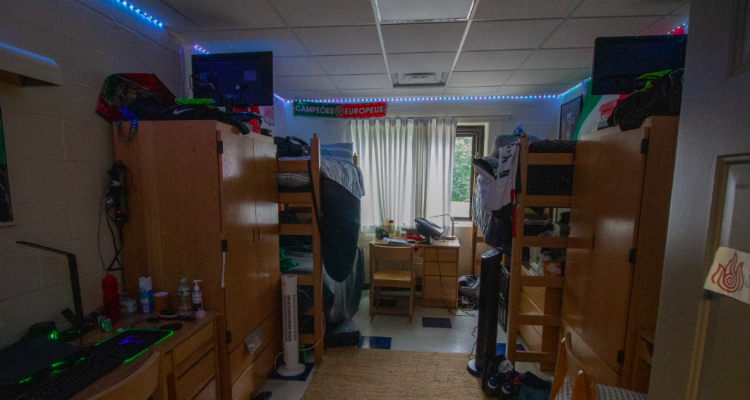The Office of Residence Life has undergone a lot of strain since the start of the COVID-19 pandemic.
With in-person events back in residence halls and high vaccination rates on campus, things are changing for students’ new homes away from home.
The sense of community from simply walking outside is refreshing, as many students are now heading to classes and other events or clubs in-person.
Although masks are still worn indoors, being able to be in a friend’s room in another building is a new privilege even for those who have been on campus for a year.
Things are starting to return to normal again, but a new problem has emerged for the people in Residence Life and a portion of the incoming Class of 2025: a lack of housing.
New buildings are being built each year to accommodate the new increase as part of Fairfield University’s master plan, “Fairfield 2020, The Way Forward,” which launched in 2015.
In 2019, The Barnyard Manor townhouses were opened to house 200 more upperclassmen students, a new section of Barnyard Manor was opened this semester to house even more students.
It’s important to note that back in 2018, when this decision was being made, there was a significant amount of push back from the community due to the need to destroy the historic building of the 19th century Sturges farm.
One Fairfield resident emailed the Town Plan and Zoning Commission in October of 2019 asking, “Why do they [Fairfield University] need to tear down part of the town’s history for new dorms? And, more importantly, why aren’t they putting money toward maintaining the dorms of North Benson Road [the current townhouses]?”
Fairfield pushed through and the construction was complete.
But, the problem of lack of housing still impacts the University.
To combat this, locations on campus typically just for upperclassmen students have been used to house underclassmen. Sophomores, who are usually placed in the quad dorms (42 Langguth Hall, Faber Hall, 70 McCormick Road and Loyola Hall) or in the Village (Kostka and Claver) have been placed in apartment style buildings of 47 Mahan Road and Meditz Hall).
Even with this shift, the need for converted triples emerged for First-Year students this year.
Meredith Smith, associate dean of students and director of the Office of Residence Life, provided some clarity on the situation.
“From a Residence Life standpoint, we had more students accepted than we expected,” she states. “It was a little bit of a surprise, but not uncommon.”
Looking back on her first year working at Fairfield nearly 11 years ago, Smith recounted a separate occasion where they had to convert triples for incoming students.
As far back as 2011, the rate of full time undergraduates at Fairfield has grown. 10 years ago, there were around 3,400 full time undergraduate students and today there are about 4,300.
According to Residence Life, this year, nearly 16 percent of first years living on campus are in rooms converted from the standard doubles to triples to make room for everyone. All first year residence halls, Gonzaga Hall, Loyola Hall, Jouges Hall, Regis Hall and Campion Hall, have converted triples spread throughout.
Over the summer, students had the ability to opt into a triple, but none could opt out unless they provided a medical reason. As a way to alleviate this situation, students currently living in triples received $750 off the room and board charges, and if a student has not been “detripled” by Oct. 12, they will receive another $750 off.
“If the student was ‘detripled’ they would still keep that second $750 credit,” Smith begins. “We want to honor that commitment as a way of saying, ‘Hey, we understand that this is an inconvenience.’”
Sophomore Pedro Garcia, a resident assistant in Jogues Hall, notes that his building has 20 triples all throughout.
When asked if he has seen a positive experience from this, he said, “Even if they do like their roommates, the confined living space makes everything difficult.”
Sophomore Maria Betancur, a New Student Leader teaching a First Year Experience class on campus, has heard a small amount of positive feedback, “I’ve had students living in a triple look on the positive side and tell me, ‘Two new friends is better than one’.”
The transition period for first years is already difficult, but some students have noted that they now have to learn to adapt their schedules around multiple people instead of just one and learn how to live that way and feel comfortable.
First-year Anna McDonnell, a student who lives in a Gonzaga triple, gave similar comments on the situation. “I’m used to being able to come home from school and relax in my room,” she states. “Now, it’s even more busy with people moving in and out than it would have been with one person.”
She continues saying, “Having total privacy is increasingly more difficult now with two roommates rather than one. I have to go somewhere like the Mezzanine to get complete alone time. The size of the space is also very draining to maneuver around already.”
Residence Life will continue to work towards getting out as many students in triples as they can manage.
As of writing this article, the university has yet to make known plans to expand the housing options on campus. Most recently, Fairfield has built the gaming lab in the Rec-Plex and is still constructing the Arena and Convocation Center where the basketball teams will host their home games.
At this rate, a new residence hall will likely be needed, but many questions remain. How big would it be? What kind of housing would it provide and for what grade? Where does Fairfield even have room to build it?
First years on campus may see triples now, but there’s a good possibility they’ll get to see the start of some new buildings and renovations.


Leave a Reply